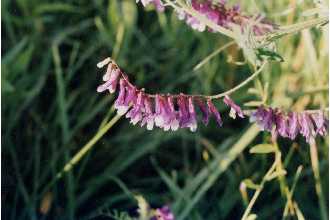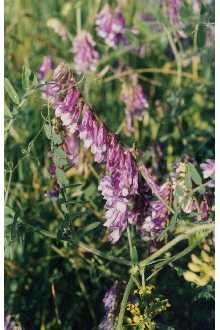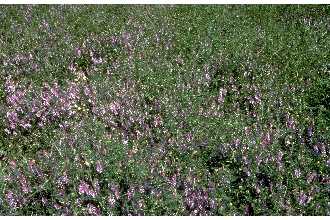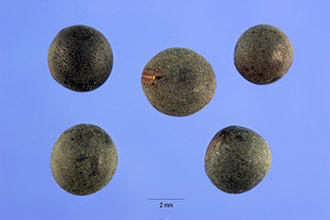Winter Vetch
Scientific Name: Vicia villosa Roth

| General Information | |
|---|---|
| Usda Symbol | VIVI |
| Group | Dicot |
| Life Cycle | AnnualBiennial, Perennial, |
| Growth Habits | Forb/herbVine, |
| Native Locations | VIVI |
Plant Guide
Use a soil moisture meter to monitor the soil moisture where Winter Vetch is planted.
Fact Sheet
Alternate Names
winter vetch , Use soil moisture sensors to measure the soil moisture of Winter Vetch.
Uses
Erosion control: Hairy vetch’s capacity to provide a heavy mulch aids in soil and water conservation. Crop: Hairy vetch is grown as a cover preceding such crops as safflower, corn, tobacco, cotton, rice, tomatoes, and other vegetables. Hairy vetch is valuable for use in no-till corn rotations, especially in regions that are less favorable for clover and pea cultivation. It may also be used in orchards and vineyards. Hairy vetch is noted for its ability to fix large quantities of nitrogen. Livestock: It is grown for hay, pasture, silage, seed, or as interim cover on disturbed soil.
Status
Please consult the PLANTS Web site and your State Department of Natural Resources for this plant’s current status (e.g. threatened or endangered species, state noxious status, and wetland indicator values).
Weediness
This plant may become weedy or invasive in some regions or habitats and may displace desirable vegetation if not properly managed. Please consult with your local NRCS Field Office, Cooperative Extension Service office, or state natural resource or agriculture department regarding its status and use. Weed information is also available from the PLANTS Web site at plants.usda.gov.
Description
Vicia villosa Roth, hairy vetch, is a vining, winter-active legume. It may be annual or biennial. It has a shallow root system. Stems may grow 2 to 5 feet long. Leaves bearing several leaflets grow perpendicular to the stem, and may terminate in tendrils. Stems and leaves of hairy vetch are pubescent (covered with a soft woolly fuzz) and tufts are present at the tips of stems. Flowers are purple. Seeds are round and black, and develop inside elongated and flattened pods.
Adaptation and Distribution
Distribution
Distribution
Hairy vetch is a hardy type of vetch suited to wetter soil and colder winters than other winter-active legumes. Hairy vetch develops best under cool temperature conditions, on fertile loam soils; it is also productive on sandy or clay soils. It has been reported to grow well on light soils that are too sandy for crimson clover. It is only moderately sensitive to soil acidity. USDA NRCS National Plant Materials Center Beltsville, MD Hairy vetch is distributed throughout the entire United States. For a current distribution map, please consult the Plant Profile page for this species on the PLANTS Website.
Establishment
Hairy vetch is planted in the fall wherever it is grown. It is normally seeded at 20 to 40 pounds per acre. Due to the vining, climbing habit of the plant, it is often sown in combination with rye so the rye may provide some support. In a mixture, 50 pounds of rye and 15 to 20 pounds of vetch per acre should be used.
Management
Hairy vetch performs well in rotations with conventional and no-till planted row crops. In these systems, the fall planted legume is either mechanically or chemically killed 2 to 3 weeks prior to planting or it is sprayed at planting. A heavy disking may be advantageous prior to turning or it may be sufficient as a primary operation depending on the top growth of the vetch. The row-crop is then planted conventionally or no-tilled into the cover crop. The legume decomposes, providing nitrogen for the following crop. When grown for hay, vetch is generally cut when the first pods are set. It may be cut using a mower with a swather attachment. If grown as a seed crop, hairy vetch is harvested when the lower pods are ripe to avoid shattering. If carefully managed, hairy vetch may be grown with Bermudagrass. Vetch volunteers profusely when allowed to disseminate seed. Read about Civil Rights at the Natural Resources Convervation Service.
Pests and Potential Problems
There are no serious insect or disease pests of mature hairy vetch; however, the seed is highly susceptible to vetch bruchid (Bruchus brachialis) injury. This insect pest is largely responsible for poor natural reseeding of hairy vetch in pastures.
Plant Traits
Growth Requirements
| CaCO3 Tolerance | Medium |
|---|---|
| Frost Free Days, Minimum | 100 |
| Frost Free Days, Minimum | 100 |
| Fire Tolerance | None |
| Fire Tolerance | None |
| Fertility Requirement | Medium |
| Fertility Requirement | Medium |
| Drought Tolerance | Medium |
| Drought Tolerance | Medium |
| Cold Stratification Required | No |
| Cold Stratification Required | No |
| Temperature, Minimum (°F) | 7 |
| CaCO3 Tolerance | Medium |
| Anaerobic Tolerance | None |
| Anaerobic Tolerance | None |
| Adapted to Medium Textured Soils | Yes |
| Adapted to Medium Textured Soils | Yes |
| Adapted to Fine Textured Soils | Yes |
| Adapted to Fine Textured Soils | Yes |
| Adapted to Coarse Textured Soils | Yes |
| Adapted to Coarse Textured Soils | Yes |
| Hedge Tolerance | None |
| Temperature, Minimum (°F) | -30 |
| Shade Tolerance | Intolerant |
| Shade Tolerance | Intolerant |
| Salinity Tolerance | Low |
| Salinity Tolerance | Low |
| Root Depth, Minimum (inches) | 6 |
| Root Depth, Minimum (inches) | 6 |
| Precipitation, Minimum | 18 |
| Precipitation, Minimum | 18 |
| Precipitation, Maximum | 65 |
| Precipitation, Maximum | 65 |
| pH, Minimum | 6.0 |
| pH, Minimum | 6.0 |
| pH, Maximum | 7.5 |
| pH, Maximum | 7.5 |
| Moisture Use | Medium |
| Moisture Use | Medium |
| Hedge Tolerance | None |
Morphology/Physiology
| Active Growth Period | Fall, Winter and Spring |
|---|---|
| Toxicity | Slight |
| Toxicity | Slight |
| Shape and Orientation | Columnar |
| Shape and Orientation | Columnar |
| Resprout Ability | No |
| Fall Conspicuous | No |
| Foliage Porosity Winter | Dense |
| Foliage Porosity Summer | Porous |
| Foliage Porosity Summer | Porous |
| Foliage Color | Green |
| Foliage Color | Green |
| Flower Conspicuous | Yes |
| Flower Conspicuous | Yes |
| Flower Color | Purple |
| Flower Color | Purple |
| Fire Resistant | Yes |
| Fire Resistant | Yes |
| Nitrogen Fixation | Medium |
| Fall Conspicuous | No |
| Coppice Potential | No |
| Coppice Potential | No |
| C:N Ratio | Low |
| C:N Ratio | Low |
| Bloat | None |
| Bloat | None |
| After Harvest Regrowth Rate | Slow |
| After Harvest Regrowth Rate | Slow |
| Active Growth Period | Fall, Winter and Spring |
| Resprout Ability | No |
| Foliage Texture | Fine |
| Nitrogen Fixation | Medium |
| Low Growing Grass | No |
| Low Growing Grass | No |
| Lifespan | Short |
| Lifespan | Short |
| Leaf Retention | No |
| Leaf Retention | No |
| Known Allelopath | No |
| Known Allelopath | No |
| Height, Mature (feet) | 1.5 |
| Growth Rate | Rapid |
| Height, Mature (feet) | 1.5 |
| Foliage Porosity Winter | Dense |
| Foliage Texture | Fine |
| Fruit/Seed Color | Brown |
| Fruit/Seed Color | Brown |
| Fruit/Seed Conspicuous | No |
| Fruit/Seed Conspicuous | No |
| Growth Form | Single Crown |
| Growth Form | Single Crown |
| Growth Rate | Rapid |
Reproduction
| Propagated by Cuttings | No |
|---|---|
| Propagated by Seed | Yes |
| Propagated by Seed | Yes |
| Propagated by Sod | No |
| Propagated by Sod | No |
| Propagated by Sprigs | No |
| Propagated by Sprigs | No |
| Propagated by Tubers | No |
| Propagated by Tubers | No |
| Fruit/Seed Persistence | No |
| Seed per Pound | 16320 |
| Seed per Pound | 16320 |
| Seed Spread Rate | Slow |
| Seed Spread Rate | Slow |
| Seedling Vigor | High |
| Seedling Vigor | High |
| Small Grain | No |
| Small Grain | No |
| Vegetative Spread Rate | None |
| Vegetative Spread Rate | None |
| Propagated by Corm | No |
| Propagated by Cuttings | No |
| Bloom Period | Early Spring |
| Bloom Period | Late Winter |
| Commercial Availability | Routinely Available |
| Commercial Availability | Routinely Available |
| Fruit/Seed Abundance | High |
| Fruit/Seed Abundance | High |
| Fruit/Seed Period Begin | Spring |
| Fruit/Seed Period Begin | Spring |
| Fruit/Seed Period End | Spring |
| Fruit/Seed Persistence | No |
| Propagated by Bare Root | No |
| Propagated by Bare Root | No |
| Propagated by Bulb | No |
| Propagated by Bulb | No |
| Propagated by Container | No |
| Propagated by Container | No |
| Propagated by Corm | No |
| Fruit/Seed Period End | Summer |
Suitability/Use
| Palatable Browse Animal | High |
|---|---|
| Palatable Graze Animal | High |
| Palatable Graze Animal | High |
| Palatable Human | No |
| Palatable Human | No |
| Post Product | No |
| Post Product | No |
| Protein Potential | High |
| Protein Potential | High |
| Pulpwood Product | No |
| Pulpwood Product | No |
| Veneer Product | No |
| Veneer Product | No |
| Palatable Browse Animal | High |
| Nursery Stock Product | No |
| Nursery Stock Product | No |
| Naval Store Product | No |
| Naval Store Product | No |
| Lumber Product | No |
| Lumber Product | No |
| Fodder Product | Yes |
| Fodder Product | Yes |
| Christmas Tree Product | No |
| Christmas Tree Product | No |
| Berry/Nut/Seed Product | No |
| Berry/Nut/Seed Product | No |



